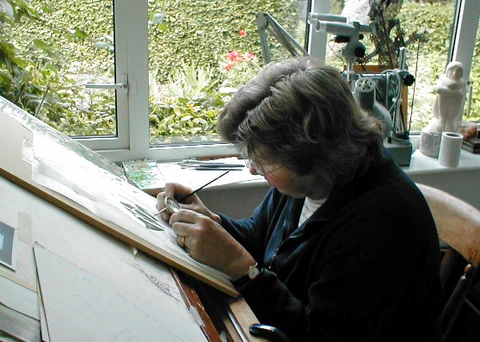It has been four years since Tuesday, 9th May 2017, a sad day in the long history of botanical art. For it was on that day that Pandora Sellars passed away.
In 2011, I posted the article below, Spotlight on Pandora Sellars. At the time I quoted from the catalogue of her exhibition at Kew in 1990. I couldn’t think of a better way to describe her. I still can’t. So here, in remembrance of a most remarkable botanical artist and person, and my mentor, is that post again . . .
Spotlight on Pandora Sellars

© Margaret Best
Pandora Sellars teaching a workshop for a lucky few of us in a 18th century coaching inn in Alderminster, Warwickshire.
Where to begin to tell the story about this icon of contemporary botanical art? The lists of exhibitions in which she has participated, the publications in which she has appeared and the recognition that she has enjoyed, could on their own fill the body of this article.
Pandora’s initial enthusiasm for drawing and painting plants has been ascribed to her rural childhood in the Welsh Marches in Herefordshire, England. Her home was close to the Wye Valley and the Black Mountains where she had access to a diverse and fascinating array of flora. At art school she designed printed fabrics and taught but all the time kept on painting plants. When her late husband built a heated greenhouse, the exotic plants that he collected became Pandora’s inspiration. She had a particular interest in painting the orchids for which she is now so well known.
It is difficult to describe my mentor in a way that does this hugely talented, delightfully gentle person justice. The closest I can come is by quoting the introduction that was published in the catalogue of her exhibition, Pandora Sellars botanical painting 1974 – 1990 at the Kew Gardens Gallery in 1990…
“For many years, Pandora Sellars was, to me, a somewhat mysterious figure whose name was mentioned with great reverence by my colleagues in the Botanical World who would regularly use ‘spectacular’, ‘incredibly accurate’, ’amazing detail’ and similar expressions to describe work of hers which they had seen. Showing my usual level of respect for scientists’ views on artistic matters I ignored those comments until I saw a copy of Frances le Sueur’s Flora of Jersey, which was illustrated by Pandora Sellars, and also an original painting of hers on the wall of a friend’s house in Suffolk. My conversion was immediate and, once I had looked in some detail at the paintings she had been doing for publication in the Botanical Magazine from 1982 onwards, I joined the ever-growing band of those using highly complimentary words when referring to her paintings.
Soon after joining the staff of Kew in 1986 I met Pandora for the first time, saw more of her outstanding work and resolved that Kew, one day, must give her an exhibition. At that time the Kew Gardens Gallery was no more than a nice idea five years from fulfillment. In fact we opened the Gallery in November 1988 and, at the same time, began discussions with Pandora about an exhibition at Kew. Her schedule of commissions prevented her from exhibiting in our first year but we were delighted to work towards our spring exhibition in 1990.
When, in the middle of last summer, she arrived with her first paintings for the exhibition, I was stunned by what she had produced. It was not that area of paper that she had covered nor the number of paintings which impressed me – for her style is detailed, painstaking and consequently slow – but it was the sheer overwhelming quality of her work and her remarkable ability to incorporate a number of plants in a set piece which looked like a ‘corner of nature’ which took me by surprise. These set pieces were real botanical theatre with living subjects which seemed a million miles away from the traditional association between flower painting and what is called English still life.
Her pictures have come in steadily over the past twelve months, each consignment as eagerly awaited as the last and each building on the last in virtuosity. None disappointed.
Looking over the twenty or so works painted specially for this exhibition one is immediately aware of being in the presence of a consistent and superior talent in the delineation of plants: the fidelity to nature is absolute; the quality of draughtsmanship unwavering; the use of colour impeccable and the representation of texture without equal. Just as many of us first respond musically to large-scale works such as symphonies, so it is the large-scale ‘plant symphonies’ which instantly attract and are most accessible. Chamber works often appeal later as knowledge and appreciation matures. Similarly one moves from admiration for the large complex paintings to a deep respect for the elegant but simple plant portraits which have formed the main body of her work for over ten years.
As must be obvious from this short introduction I have the highest possible admiration for her work and I remain to be convinced that the world has ever known a botanical painter with a greater talent than Pandora Sellars. Ehret, Redouté, Turpin, Lilian Snelling come close. Fitch, prolific, liberated and wonderful in his way approaches, and several living artists come even closer but for me, only the brothers Bauer occupy, with her, the corner of the botanical world in which one can truly say that no one has ever done it better. But, were the Bauers so good at painting leaves?”
Nothing more needs to be added other than to steal this glimpse of Pandora in her studio. This was where so much brilliance was given expression . . .

Photo credit: Margaret Best

